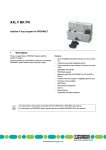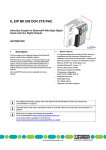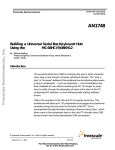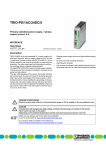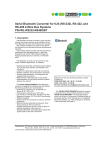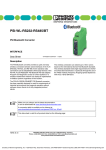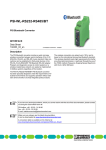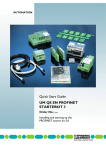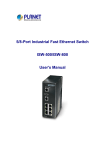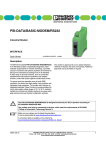Download Data Sheet DB EN PSI-MODEM-SHDSL/ETH
Transcript
PSI-MODEM-SHDSL/ETH Ethernet extender firmware 3.0 or later Data sheet 104287_en_05 1 © PHOENIX CONTACT 2013-08-21 Description The Ethernet extender PSI-MODEM-SHDSL/ETH can be used to easily network Ethernet devices with one another. A distance of up to 20 km can lie between the two devices. Transmission speeds of up to 30 Mbps are possible. Any cables, e.g., in-house phone lines, can be used for remote communication. Special Ethernet or fiberglass cables are not required. Point-to-point connections and line structures can be established with the Ethernet extenders. Ring structures are also possible from firmware version 3.0. It is not necessary to assign an IP address to start up the Ethernet extender. Like a media converter the Ethernet extender uses a transparent protocol. The DSL data rate is detected automatically. The transmit and receive cables in the Ethernet cable are crossed automatically. For most applications, the Ethernet extender does not need to be configured (plug and play). In all other cases, the PSICONF configuration software is available free of charge. To configure the Ethernet extender, it only needs to be supplied with current via the USB interface. For quick local path diagnostics, the Ethernet extender provides LEDs on the device front, an integrated diagnostic function, and a log book. The extender can transmit additional status messages to, for example, a controller using two digital outputs. 1.1 Areas of application The Ethernet extender is designed to retrofit systems that have been removed with Ethernet via the existing cable infrastructure. For example in the sectors: – Water and wastewater – Process engineering – Large-area industrial systems – Traffic technology – Railway companies – Power engineering – Photovoltaics – Wind energy – Building technology – Mining In addition, it can be used to enable Ethernet communication via a slip ring. On page 8 we show an example of rotating applications where communication is built-up redundantly by means of fiber optics and copper. For example in the sectors: – Wind energy – Water and wastewater Make sure you always use the latest documentation. It can be downloaded at phoenixcontact.net/products. This data sheet is valid for all products listed on the following page: www.phoenixpowersupply.co.uk PSI-MODEM-SHDSL/ETH 2 Features Data transmission – Plug and play – Distances of up to 20 km between two devices – Data rates of up to 30 Mbps (4-wire) – Data rates of up to 15.3 Mbps (2-wire) – Robust modulation method (SHDSL) for large distances – Via in-house cables, not via the public telephone network Topologies (see page 7) – Point-to-point – Line structure – Ring structure (firmware 3.0 or later; from firmware 2.1 with RSTP-capable switch) For older devices, the latest firmware can be downloaded free at phoenixcontact.net/products. – Redundancy operation 3 Ethernet interface – Plug and play – No IP configuration required – Transparent protocol (IPv4 and IPv6) – RSTP (Rapid Spanning Tree Protocol) support – PROFINET (strict priority) Additional features – Two digital outputs for status transmission – Configuration software for extended functionality – Online diagnostics – Log book function including event description and suggested solution – Saving and printing of project and device configurations Ordering data Ethernet extender Description Industrial Ethernet extender, for point-to-point connections, line and ring structures. Data rates of up to 30 Mbps on the in-house copper cables, integrated diagnostic function, two configurable alarm outputs Accessories Description System power supply unit, Primary-switched Input voltage range Nominal output voltage Nominal output current Type Order No. Pcs. / Pkt. PSI-MODEM-SHDSL/ETH 2313643 1 Type Order No. Pcs. / Pkt. MINI-SYS-PS-100-240 AC/24 DC/1.5 2866983 1 45 Hz ... 65 Hz 85 V AC ... 264 V AC 24 V DC ±1 %, 1.5 A DIN rail connector (2x required) ME 17.5 TBUS 1.5/ 5-ST-3.81 GN 2709561 1 Attachment plug with surge protection for two analog or digital SHDSL telecommunications interfaces. Connection: RJ45 (RJ12/RJ11) and screw terminal block (COMBICON). Can alternatively be snapped onto DIN rails DT-TELE-SHDSL 2801593 1 USB cable, USB type A/mini-USB type B, 5-pos., 3 m long CABLE-USB/MINI-USB-3.0M 2986135 1 104287_en_05 PHOENIX CONTACT www.phoenixpowersupply.co.uk 2 PSI-MODEM-SHDSL/ETH 4 Technical data Supply Supply voltage 18 V DC ... 30 V DC via plug-in COMBICON screw terminal block 24 V DC ±5 % (alternative or redundant, via DIN rail connector and system power supply) 5 V DC (configuration only, via mini-USB type B) Nominal current consumption < 180 mA (at 24 V) LED indicator VCC (green LED) Steady light: operation Flashing at 1 Hz: supply via USB (for configuration) Switching outputs 2 x UNom/ 150 mA (the digital outputs cannot be used for power supply via the DIN rail connector), short-circuit-proof The digital switching outputs can be connected to a load between 100 kOhm and 0.2 kOhm. SHDSL interface Connection method 2 x 2-pos. COMBICON plug-in screw terminal block Type SHDSL interface according to ITU-T G.991.2.bis Serial transmission speed 4-wire operation 64 kbps ... 30 Mbps (manual selection of the data rate) 384 kbps ... 11.39 Mbps (automatic detection of the data rate) 2-wire operation 32 kbps ... 15.3 Mbps (manual selection of the data rate) 192 kbps ... 5.696 Mbps (automatic detection of the data rate) Transmission length Over 20 km possible at lower data rates and with good cable quality Connection data (conductor cross section) 0.2 mm² ... 2.5 mm² (24 - 14 AWG) Status and diagnostic indicators 2 x LINK, 2 x STAT (DSL data traffic port A and port B) DIAG (yellow LED), diagnostic messages ERR (red LED), errors Ethernet interface Connection method RJ45 socket, 8-pos, shielded Type 10/100 BASE-T(X) according to IEEE 802.3u Transmission speed 10/100 Mbps, auto negotiation Transmission length Maximum 100 m (twisted pair, shielded) Supported protocols Transparent protocol for IPv4 and IPv6 Status and diagnostic indicators ACT (yellow LED), Ethernet data transmission LINK (green LED), Ethernet link established ERR (red LED), errors DIAG (yellow LED), diagnostic messages USB interface (configuration/diagnostics) Connection method Mini-USB type B, 5-pos. Type USB 2.0 Transmission length Maximum 5 m, only for configuration and diagnostics 104287_en_05 PHOENIX CONTACT www.phoenixpowersupply.co.uk 3 PSI-MODEM-SHDSL/ETH General data Ambient temperature range Operation (no other modules supplied via the device): – Freestanding (40 mm spacing) -20°C ... +60 °C – Connected in series (low power dissipation of modules connected in se- -20°C ... +55 °C ries) -20°C ... +50 °C – Connected in series (without restrictions) -20°C ... +45 °C Operation (other modules supplied via the device (1.5 A, maximum)) -40°C ... +85 °C Storage/transport Housing Material Dimensions (H x W x D) Device weight ME 35 with 5-pos. bus contact and ground contact PA 6.6-FR, V0, green 114.5 x 35 x 99 mm 185 g MTBF according to Telcordia standard Ambient temperature of 25°C 1017 years Ambient temperature of 40°C 205 years Functional earth ground Housing contact to DIN rail Degree of protection IP20 Electrical isolation Supply voltage //Ethernet // DSL port A // DSL port B // FE Test voltage 1.5 kV AC, 50 Hz Vibration resistance According to IEC 60068-2-6: 5g, 150 Hz Noise immunity EN 61000-6-2 Electromagnetic compatibility Conformance with EMC Directive 2004/108/EC Manufacturer's declaration EN 50121-4 (Railway applications - Electromagnetic compatibility, Part 4: Emission and Immunity of the Signaling and Telecommunications Apparatus) Exceptions include installations within the 3 m area and safety-related devices. For these devices, there are further requirements according to EN 50121-4 Table 1, Note 1. Section 1, Paragraph 3 of EN 50121-4 applies. Phoenix Contact QUINT power supply units are to be used directly on the device. UL, USA/Canada Conformity assessment according to directive 94/9/EC 4 II 3 G Ex nA nC IIC T4 Gc X 104287_en_05 PHOENIX CONTACT www.phoenixpowersupply.co.uk 4 PSI-MODEM-SHDSL/ETH 5 Supply voltage There are different voltage supply options. In addition to voltage supply via the plug-in screw terminal blocks, the device can also be supplied via the DIN rail connectors. This increases the reliability and reduces the wiring effort. For more information, please refer to the UM EN PSI-MODEM-SHDSL/ETH user manual. 24V 0V Figure 1 Voltage supply via plug-in screw terminal blocks Figure 2 Voltage supply via DIN rail connectors 104287_en_05 PHOENIX CONTACT www.phoenixpowersupply.co.uk 5 PSI-MODEM-SHDSL/ETH 6 Range 6.1 DSL technology In contrast to an analog permanent line modem, DSL (Digital Subscriber Line) uses a greater frequency range, which enables a many times higher data rate. The maximum possible data rate is dependent on several parameters. Two important parameters are the cable length and cable cross section. With DSL, the modulation process is used on different carrier frequencies, in this way enabling robust modulation that is significantly less sensitive against external electro-magnetic sources of disturbance. SHDSL is standardized in the ITU-T G.991.2. Further technical information can be found there. Ethernet extenders with SHDSL technology are suited for retrofitting systems because wires that have already been laid may continue to be used. 6.2 14.0 12.0 Data rate [ Mbps The DSL technology used here is the SHDSL variant. A greater range can be realized with SHDSL than with other DSL technologies. In addition, the bandwidth for the up and down stream is equally large (symmetrical data transmission). For this reason, SHDSL is very suited to industrial applications. 16.0 11.0 PE 0.4 mm (0.13 mm²) 10.0 PE 0.9 mm (0.64 mm²) 8.0 6.0 PE 1.4 mm (1.54 mm²) 4.0 2.0 0.0 0 2 Figure 3 Determination of data rate A precise prediction of the maximum possible data rate is difficult in practice as many parameters play a role. These include the type of cable (structure, diameter, capacity, shielding) and how it is installed (number of crossovers, influence of cables laid parallel, EMC influences of neighboring devices on the communication line). During a new installation, we recommend using shielded twisted pair cables. An initial estimation of the possible data rate is possible using the (Figure 3) diagram or via the SHDSL calculator software. The software can be downloaded for free at phoenixcontact.net/products. 4 6 8 10 km 12 14 16 18 20 Data rate (Mbps) depending on the line length in a 2-wire connection. Figure 3 illustrates the dependency of the maximum data rate on the line length with three cable types. Longer distances can be achieved using high-quality cables with larger diameters. The industrial Ethernet extenders from Phoenix Contact support data rates of 32 kbps to 15.3 Mbps in 2-wire operation and data rates of up to 30 Mbps in 4-wire operation. The Ethernet extenders are suitable for in-house cables, not for public telephone networks. Establishing the connection between the Ethernet extenders usually takes around one minute. The actual data rate can be determined with a practical test. Phoenix Contact provides test kits with two Ethernet extenders, with which the path can be tested under realistic conditions. 104287_en_05 PHOENIX CONTACT www.phoenixpowersupply.co.uk 6 PSI-MODEM-SHDSL/ETH Point-to-point connection 7.2 Line structure SHDSL 15.3 Mbps, maxi- SHDSL 4-wire SHDSL ETH 15.3 Mbps, maxi- 15.3 Mbps, max- ETH ETH SHDSL 4-wire SHDSL SHDSL 30 Mbps, maxi- SHDSL 4-wire SHDSL SHDSL SHDSL 4-wire SHDSL SHDSL SHDSL 4-wire SHDSL 7.1 SHDSL Application examples SHDSL 7 30 Mbps, maxiETH ETH There can be a maximum distance of 20 km between two devices. As of firmware 2.1, the Ethernet extender automatically recognizes if the path is constructed on a 2- or 4-wire path. After a 4-wire connection has been detected, the transmission speed is increased automatically depending on the line quality. It is usually doubled. If one of the connections fails, the data is transmitted via the remaining wires at single transmission speed. In this way, a reliable redundancy operation is supported. There can be a maximum distance of 20 km between two devices. In one line, up to 255 devices can be connected in series. For more information, please refer to the UM EN PSI-MODEM-SHDSL/ETH user manual. 7.3 Star structure For more information, please refer to the UM EN PSI-MODEM-SHDSL/ETH user manual. SHDSL SHDSL Only three devices are required instead of four because of the two SHDSL ports on each device. 104287_en_05 PHOENIX CONTACT www.phoenixpowersupply.co.uk 7 PSI-MODEM-SHDSL/ETH 7.4 Ring structure (firmware 3.0 or later) As of firmware 3.0, a ring structure can be created without using a switch. With firmware 2.1, a managed switch was still necessary. Special application: Redundant data communication in wind-powered systems Figure 5 There can be a maximum distance of 20 km between two devices. Up to 50 devices can be integrated into one ring structure. If there is a ring interruption, Ethernet communication is possible again after the following response time: tRecovery = 600 ms + Number of devices x 100 ms The paths of the SHDSL ring should show a very high connection quality during normal operation. Otherwise the tRecovery can deviated from the value calculated above. 7.5 Redundant data communication in rotating applications The example shows a slip ring communication. Figure 4 Slip ring The example shows the structure of a wind-powered system, with which the data communication between hub and nacelle should be ensured via a redundant network. Independent transmission paths are used for data communication. Standard Ethernet data transmission is based on two WDM media converters in fiber optic technology (e.g. via FL MC EF WDM-SET SC, 2902660). For fiber optic transmission, an optical rotary transformer with a single fiber is used, which is integrated in the axis of the existing copper slip ring. The redundant path is constructed with the aid of Ethernet extenders. The existing copper slip ring is used for the SHDSL connection and redundancy management is ensured via managed switches (e.g. via the switches FL SWITCH LM 8TX, 2832632 or FL SWITCH SMCS 8TX, 2989226; Phoenix Contact has additional RSTP capable switches on offer). Slip ring communication The Ethernet extenders are connected in this application via a 4-wire path. The connection is therefore redundantly established. With the two digital outputs of the Ethernet extender, communication can be monitored via the slip ring. 104287_en_05 PHOENIX CONTACT www.phoenixpowersupply.co.uk 8 PSI-MODEM-SHDSL/ETH 8 Functions in firmware 3.0 This behavior is advantageous if the devices are used within redundant structures. When using the current firmware version 3.0 and the PSI-CONF 2.03 configuration software, these functions are additionally available. The firmware and configuration software can be downloaded free at phoenixcontact.net/products. 8.1 Ring structure without managed switch To establish a ring structure, just connect the devices as a ring. It is not necessary to assign an IP address to start up the Ethernet extender. It uses a transparent protocol like a simple media converter. In the ring, the path with the worst transmission features is not used. It serves as alternative path in the case of error. 8.2 Remote diagnostics and remote configuration With the configuration software, you can also access removed Ethernet devices and configure or diagnose these. If connection establishment is at first no longer possible because of a defective remote configuration, after a while switch the corresponding devices automatically into a special emergency mode. In this mode, the devices establish the connection again automatically so that they can continue to access the removed devices. 8.3 Firmware update With the configuration software you can up-date all reachable Ethernet extenders at once with a firmware update. 8.4 SHDSL Figure 7 Transparent link Without this function the Ethernet connection remains unchanged on the network side when the SHDSL connection is interrupted. 8.5 Preferred forwarding of high-priority data When forwarding Ethernet telegrams, it is ensured that highpriority data (e.g. process data) will not be affected by a bandwidth bottleneck for as long as possible. This means that telegrams are forwarded according to the strict priority method in a PROFINET-compliant manner. 8.6 Increasing noise immunity Noise immunity can be increased when you reduce the data rate. There are two options in the configuration software. – Switch the data rate detection to "manual" and reduce the data rate. – Leave the data rate detection set to "automatic" and change the noise immunity with the slider. Control with the slider is especially suitable for longer paths. With slip rings, manual setting is better. Informing Ethernet device about aborted SHDSL (transparent link) With a point-to-point connection, you can switch on the function "transparent link" via the configuration software. Figure 8 Figure 6 Slider in PSI-CONF Transparent link in PSI-CONF This function ensures that during an interruption of the SHDSL connection, the Ethernet connection on the network side is also aborted. This process takes around 600 ms. If however the Ethernet connection aborts on the network side instead of on the SHDSL path, then this information is not transmitted via the SHDSL path to the other network. 104287_en_05 PHOENIX CONTACT www.phoenixpowersupply.co.uk 9 PSI-MODEM-SHDSL/ETH 8.7 9 Improved diagnostics Both the local diagnostic data as well as the diagnostic data of the removed device are available to you. Use in potentially explosive areas The category 3 device is designed for installation in the potentially explosive area of zone 2. It meets the requirements of EN 60079-0 and EN 60079-15. Special conditions Observe the specified conditions for use in potentially explosive areas. WARNING: Explosion hazard Figure 9 Install the device in suitable housing with IP54 protection, minimum, that meets the requirements of EN 60079-15. Path status in PSI-CONF In the case of an event message, possible reasons and solutions are displayed when you double-click the corresponding symbol in diagnostics. WARNING: Explosion hazard Disconnect the block power supply before you: – Snap it on or disconnect it. – Connect or disconnect cables. WARNING: Explosion hazard The mini-USB configuration interface may only be used if it has been ensured that there is no explosive atmosphere. Figure 10 Diagnostic function in PSI-CONF WARNING: Explosion hazard For reliable operation, the RJ45 connector needs to have a fully functioning locking clip. Repair any damaged plug connectors immediately. WARNING: Explosion hazard Only devices which are designed for operation in zone 2 potentially explosive areas and are suitable for the conditions at the installation location may be connected to the signal circuits in zone 2. 104287_en_05 PHOENIX CONTACT GmbH & Co. KG • 32823 Blomberg • Germany phoenixcontact.com www.phoenixpowersupply.co.uk 10











